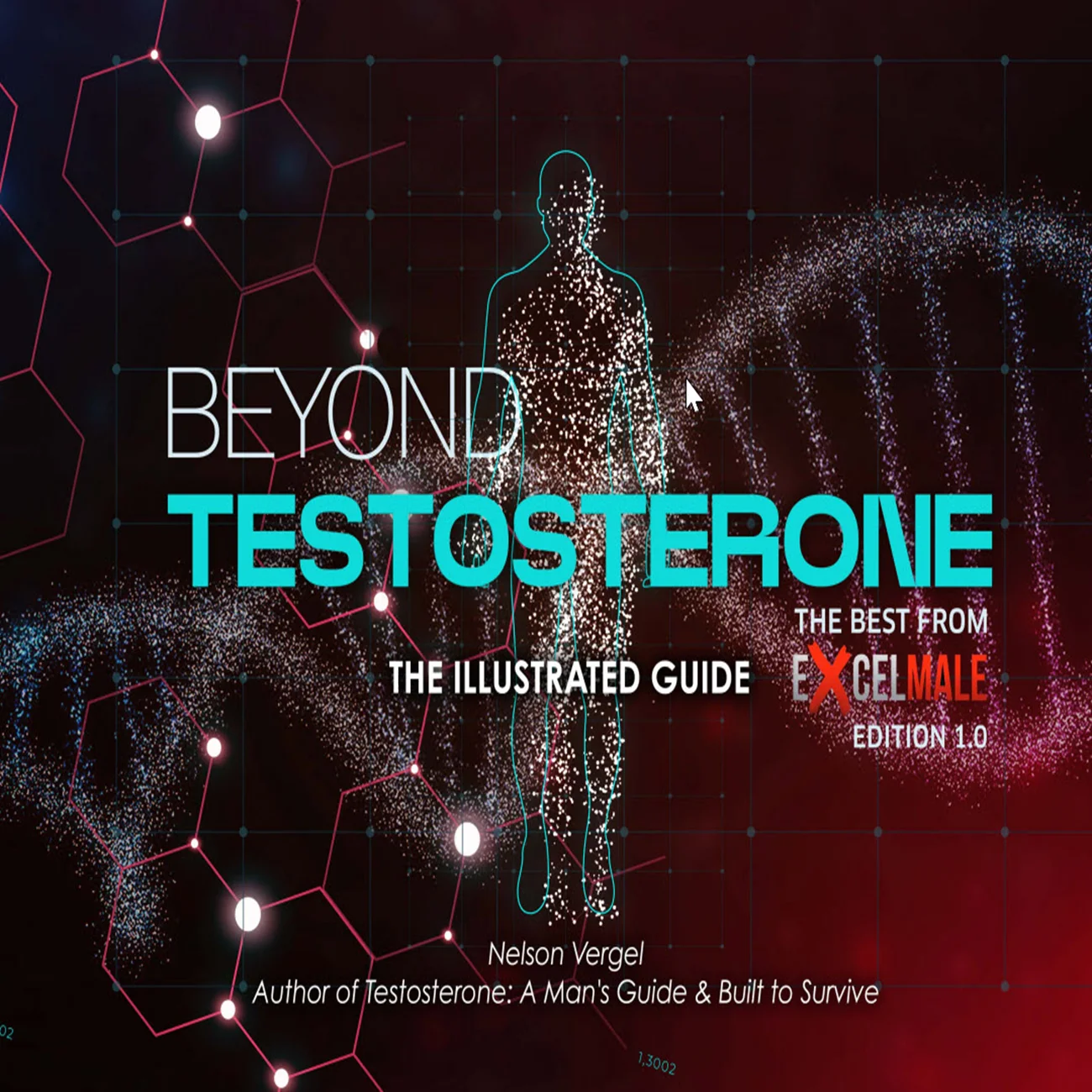Have there ever been any large studies that give an accurate range of what a typical range/percentage there is between the low and high points of a testosterone injection. For instance, I have always did best with once weekly low dose and currently do 52mg per week. My trough has been 640-660ng day seven morning of my next shot. I would like to know where I’m peaking and most likely just need to get labs but was curious if there is a range verified through studies? At one point I checked levels when doing 100mg per week and 3 days after injection I was close to 1500ng. At 100mg my trough was over 1000ng.
You are using an out of date browser. It may not display this or other websites correctly.
You should upgrade or use an alternative browser.
You should upgrade or use an alternative browser.
Peak vs trough testosterone level
- Thread starter sh1973
- Start date
-
- Tags
- labs test dosing
Ive often thought and believed that peak over trough is where we should be looking. Its a flaw in how TRT is sold to guys as in we'll keep you at the LOWEST point high physiological if not supraphysiological.
Most guys with E problems, which is most all, usually overlook the fact that their number of 29 on a LCMSMS test, which by the numbers looks good and they can't understand why they still have E symptoms and problems.
Most guys with E problems, which is most all, usually overlook the fact that their number of 29 on a LCMSMS test, which by the numbers looks good and they can't understand why they still have E symptoms and problems.
I agree and honestly think labs midway would be a better window to see what’s happening.Ive often thought and believed that peak over trough is where we should be looking. Its a flaw in how TRT is sold to guys as in we'll keep you at the LOWEST point high physiological if not supraphysiological.
Most guys with E problems, which is most all, usually overlook the fact that their number of 29 on a LCMSMS test, which by the numbers looks good and they can't understand why they still have E symptoms and problems.
You can estimate the peak-trough ratio based on the half-life of the testosterone ester. The estimate I use for weekly injections of testosterone cypionate is 2.5, which stems from a five-day half-life. This would put your peak at over 1,500 ng/dL. However, half-lives vary among individuals, so yours could be longer—meaning slower absorption—yielding less dramatic peaks. This is supported by your report of a drop from 1,500 ng/dL to ~1,000 ng/dL in about four days. These numbers put your half-life closer to seven days, and would reduce your predicted peak to more like 1,300 ng/dL. Your relatively high SHBG means these numbers for total testosterone are not as extreme as people might think. For example, with TT at 1,300 ng/dL and SHBG at 60 nMol/L your Vermeulen calculated free testosterone is about 23 ng/dL, which is close to the top of the healthy normal range for young men. A trough TT of 650 ng/dL puts cFTV at around 10 ng/dL, which is high enough to avoid being hypogonadal.
At some point I would like to get labs 2-3 times during the week to see where things are. It would be interesting.You can estimate the peak-trough ratio based on the half-life of the testosterone ester. The estimate I use for weekly injections of testosterone cypionate is 2.5, which stems from a five-day half-life. This would put your peak at over 1,500 ng/dL. However, half-lives vary among individuals, so yours could be longer—meaning slower absorption—yielding less dramatic peaks. This is supported by your report of a drop from 1,500 ng/dL to ~1,000 ng/dL in about four days. These numbers put your half-life closer to seven days, and would reduce your predicted peak to more like 1,300 ng/dL. Your relatively high SHBG means these numbers for total testosterone are not as extreme as people might think. For example, with TT at 1,300 ng/dL and SHBG at 60 nMol/L your Vermeulen calculated free testosterone is about 23 ng/dL, which is close to the top of the healthy normal range for young men. A trough TT of 650 ng/dL puts cFTV at around 10 ng/dL, which is high enough to avoid being hypogonadal.
madman
Super Moderator
Have there ever been any large studies that give an accurate range of what a typical range/percentage there is between the low and high points of a testosterone injection. For instance, I have always did best with once weekly low dose and currently do 52mg per week. My trough has been 640-660ng day seven morning of my next shot. I would like to know where I’m peaking and most likely just need to get labs but was curious if there is a range verified through studies? At one point I checked levels when doing 100mg per week and 3 days after injection I was close to 1500ng. At 100mg my trough was over 1000ng.
Would not get too caught up on the PKs!
Has anyone seen visual charts showing how testosterone levels change between TRT injections?
I'm curious whether the curves are smooth or if there are sharp peaks/drops, especially for the common esters like cypionate and enanthate.
Just looking to see what the typical pharmacokinetic profile looks like visually.
I found this post, but would like some more examples if available!:
Pharmacokinetic Profile of Subcutaneous Testosterone - Excel Male Health Forum
Regarding half-lives keep in mind that a majority of studies on the PK/PD of the various T-esters were done using IM...
MP85-14 VARIANCE IN PEAK AND TROUGH TESTOSTERONE LEVELS IN MEN USING INTRAMUSCULAR TESTOSTERONE
Bruno Nascimento*, Helen L Bernie, Elizabeth Schofield, John P. Mulhall, New York, NY
INTRODUCTION AND OBJECTIVES
In men using intramuscular testosterone (IM T), clinical experience shows us that, despite stable dosing and frequency, total testosterone peak (Tp) and trough (Tt) levels are highly variable, thus challenging the clinician to make a decision regarding dose adjustments. The goal of this study was to define...
Bruno Nascimento*, Helen L Bernie, Elizabeth Schofield, John P. Mulhall, New York, NY
INTRODUCTION AND OBJECTIVES
In men using intramuscular testosterone (IM T), clinical experience shows us that, despite stable dosing and frequency, total testosterone peak (Tp) and trough (Tt) levels are highly variable, thus challenging the clinician to make a decision regarding dose adjustments. The goal of this study was to define...
- madman
- peak/trough
- Replies: 3
- Forum: Testosterone and Men's Health Articles
MP85-14 VARIANCE IN PEAK AND TROUGH TESTOSTERONE LEVELS IN MEN USING INTRAMUSCULAR TESTOSTERONE
Bruno Nascimento*, Helen L Bernie, Elizabeth Schofield, John P. Mulhall, New York, NY
CONCLUSIONS
In our population of patients on stable IM T dose, there was a wide mean variation in both Tp (23%) and Tt (17.5%). In addition to that, 25% of patients had a maximum Tp change greater than 50% and a maximum Tt change greater than 35%. Clinicians should be aware of this high variability in levels when deciding on dose adjustment.
madman
Super Moderator
You can estimate the peak-trough ratio based on the half-life of the testosterone ester. The estimate I use for weekly injections of testosterone cypionate is 2.5, which stems from a five-day half-life. This would put your peak at over 1,500 ng/dL. However, half-lives vary among individuals, so yours could be longer—meaning slower absorption—yielding less dramatic peaks. This is supported by your report of a drop from 1,500 ng/dL to ~1,000 ng/dL in about four days. These numbers put your half-life closer to seven days, and would reduce your predicted peak to more like 1,300 ng/dL. Your relatively high SHBG means these numbers for total testosterone are not as extreme as people might think. For example, with TT at 1,300 ng/dL and SHBG at 60 nMol/L your Vermeulen calculated free testosterone is about 23 ng/dL, which is close to the top of the healthy normal range for young men. A trough TT of 650 ng/dL puts cFTV at around 10 ng/dL, which is high enough to avoid being hypogonadal.
Shit kicker here is he was still hitting a high FT 23.9 ng/dL with a trough TT 855 ng/dL and this is with high SHBG 66 nmoL/L.
His FT was tested using the most accurate assay Equilibrium Dialysis!
When he was hitting a trough TT 650 ng/dL with high SHBG he was still hitting a high trough FT 18 ng/dL.
He stated the his FT was tested numerous times using the same assay and even with a robust trough TT and high SHBG his trough FT is high.
For those that have known me over the years know that in the past, I definitely had my struggles with TRT and I’ve tried pretty much everything there is to try. I have now been on TRT the better part of 16 years and for the last several years, I’ve been using 60 mg once per week of testosterone cypionate. This has been via the intramuscular route. This normally puts my seven day low point somewhere between 700–750ng. Even if it’s overdose, I still have the phenomenon a feeling sort of bad the day after the injection and always feeling the best to wear the end of the week. This has been...
- sh1973
- cypionate trt
- Replies: 66
- Forum: Testosterone Basics & Questions
TESTOSTERONE, FREE
Males (adult):
20-<25 years: 5.25-20.7 ng/dL
25-<30 years: 5.05-19.8 ng/dL
30-<35 years: 4.85-19.0 ng/dL
35-<40 years: 4.65-18.1 ng/dL
40-<45 years: 4.46-17.1 ng
Calculated using the Vermeulen method his trough FT 12.3 ng/dL would have been much lower.
For some reason we really try to overthink things. If your numbers are good you feel good. Not much reason to change or to do crazy protocol adjustments.
It's human nature to strive for better. If we settled for "good enough" then we'd still be cave dwellers.
Vince
Super Moderator
Do you think that's why so many people today have anxiety issues?It's human nature to strive for better. If we settled for "good enough" then we'd still be cave dwellers.
Mr. AI
The more I use AI, the more flaws I see, but it really is a fantastic tool, and I have to learn how to use it more effectively.
The pursuit of excellence is a healthier alternative to perfectionism, which can be psychologically damaging. Seeking excellence involves setting high but attainable goals in a flexible and engaged manner, which research shows is associated with higher achievement and well-being.
Do you think that's why so many people today have anxiety issues?
...
Setting aside strictly biochemical dysfunction, I think in some ways it's the opposite. We evolved to face challenges and overcome them. When everything is handed to you and you can't feel a sense of purpose or accomplishment then you get mental health issues.
Vince
Super Moderator
Yes, in my opinion not having struggles can create emotional void, leading to feelings of emptiness and low self-worth. Anxiety. I don't know if that comes from not having struggles.Setting aside strictly biochemical dysfunction, I think in some ways it's the opposite. We evolved to face challenges and overcome them. When everything is handed to you and you can't feel a sense of purpose or accomplishment then you get mental health issues.
I have a few friends with very high IQs and they never learned to fail. Now they're afraid to fail and accomplished very little in their life even though they are extremely smart.
One of my granddaughters has an extremely high IQ. Top 2% in a country for comprehension and math. My daughter taught her at a young age. Without failing you will never succeed. The only way you learn is by failing if you don't fail your aren't trying, or being challenged.
Sorry I didn't use Mr. AI
I trying to find a new picture one with Mr. AI on it.
Vince
Super Moderator
I read this in Fortune today. I thought you would find it interesting.Setting aside strictly biochemical dysfunction, I think in some ways it's the opposite. We evolved to face challenges and overcome them. When everything is handed to you and you can't feel a sense of purpose or accomplishment then you get mental health issues.
“I have never met a successful person in my life who learned anything when things went well,” Sinek told Chris Williamson on his podcast, Modern Wisdom. “They learned every lesson they needed to learn that helped them achieve when things went horribly wrong.”
Yes, in my opinion not having struggles can create emotional void, leading to feelings of emptiness and low self-worth. Anxiety. I don't know if that comes from not having struggles.
...
There is some evidence for such mental health issues, including anxiety. Per Grok:
There is emerging evidence from psychology and related fields supporting the hypothesis that a lack of challenges or adversity—sometimes framed as excessive comfort, overprotection, or "coddling"—can contribute to mental health issues like anxiety in some individuals. This isn't a universal rule, as individual factors like genetics, personality, and environment play roles, but studies suggest that avoiding difficulties may hinder the development of resilience, coping skills, and emotional regulation, paradoxically fostering discord. Below, I'll outline key lines of evidence, drawing from research on parenting styles, the "comfort crisis," and the nonlinear effects of adversity.
Overprotection and Helicopter Parenting
One of the strongest bodies of evidence comes from studies on overprotective or "helicopter" parenting, where parents shield children from challenges, failures, or independence. This can limit opportunities to overcome obstacles, leading to heightened anxiety later in life.
- Research indicates that children of helicopter parents often struggle with emotional regulation and show elevated anxiety levels because they lack practice in handling stress autonomously. For instance, a study of young adults found that excessive parental involvement correlates with higher anxiety, depression, and reduced self-confidence, as it impedes the building of resilience.
- Multiple reviews and studies link overprotectiveness to social anxiety in children, with parents' tendencies to intervene preventing kids from developing problem-solving skills. This pattern extends into adulthood; first-year college students with helicopter parents report more anxiety when facing everyday stressors, such as academic or social demands.
- Broader analyses suggest this contributes to rising perfectionism and anxiety disorders among youth, as overprotection fosters low self-efficacy (belief in one's ability to handle challenges).
In essence, when life is made "too easy" through constant intervention, individuals may become more vulnerable to mental discord because they haven't built the psychological tools to navigate uncertainty or setbacks.
The "Comfort Crisis" and Excessive Ease
Popularized in Michael Easter's book The Comfort Crisis, the idea posits that modern life's overabundance of comfort—constant access to food, safety, and convenience—can erode mental well-being by removing natural stressors that humans evolved to handle. While not all evidence is from rigorous clinical trials, it draws on observational and evolutionary psychology research.
- Excessive comfort may lead to fixation on social comparisons and a loss of appreciation for basics, contributing to misery, anxiety, and depression. Easter argues that embracing discomfort (e.g., through physical challenges) builds mental toughness, while its absence links to issues like fragility and lack of meaning.
- Related concepts, like "affluenza" in affluent societies, suggest that a lack of struggle can foster entitlement, boredom, and mental health problems, as people miss out on the satisfaction of overcoming hurdles. For example, avoiding discomfort is associated with higher risks of psychological issues, as it weakens adaptability and resilience.
This perspective aligns with evolutionary views: humans thrive with periodic challenges, and their total absence can create a void that manifests as anxiety or dissatisfaction.
Curvilinear (Nonlinear) Effects of Adversity
A growing area of research examines the relationship between lifetime adversity and mental health as curvilinear—meaning moderate levels of challenge may be optimal, while both extremes (too much or too little) increase risks. This directly supports the idea that a lack of challenges could paradoxically harm mental health.
- Studies on early-life adversity (ELA) show a U-shaped or inverted U-shaped curve: low adversity is linked to poorer successful aging and mental health outcomes, similar to high adversity, because some hardship promotes growth and resilience.
- Cumulative childhood adversity relates to depressive symptoms and other issues in a positive curvilinear manner, implying that zero or very low adversity doesn't buffer against problems and may even exacerbate vulnerability.
- Mental health mediation plays a role; for instance, moderate adversity builds future orientation and well-being, while its absence may leave individuals less equipped for life's inevitable stresses.
These findings suggest that "things being too easy" might create mental discord by depriving people of opportunities to develop antifragility—the ability to grow stronger from stress.
Caveats and Broader Context
While supportive, this evidence is correlational in many cases, and causation isn't always clear (e.g., anxious parents might overprotect, perpetuating a cycle). Not everyone in low-challenge environments develops issues; protective factors like strong social support can mitigate risks. Conversely, excessive adversity clearly harms mental health in most research, so the goal isn't to seek out hardship but to allow natural challenges. If this resonates personally, consulting a mental health professional for tailored advice is recommended. Overall, yes—the hypothesis has backing, particularly in how it explains rising anxiety in overprotected or overly comfortable populations.
One of the references.Vince
Super Moderator
I have to start calling you, Mister AI. Haha.There is some evidence for such mental health issues, including anxiety. Per Grok:
There is emerging evidence from psychology and related fields supporting the hypothesis that a lack of challenges or adversity—sometimes framed as excessive comfort, overprotection, or "coddling"—can contribute to mental health issues like anxiety in some individuals. This isn't a universal rule, as individual factors like genetics, personality, and environment play roles, but studies suggest that avoiding difficulties may hinder the development of resilience, coping skills, and emotional regulation, paradoxically fostering discord. Below, I'll outline key lines of evidence, drawing from research on parenting styles, the "comfort crisis," and the nonlinear effects of adversity.Overprotection and Helicopter ParentingOne of the strongest bodies of evidence comes from studies on overprotective or "helicopter" parenting, where parents shield children from challenges, failures, or independence. This can limit opportunities to overcome obstacles, leading to heightened anxiety later in life.
- Research indicates that children of helicopter parents often struggle with emotional regulation and show elevated anxiety levels because they lack practice in handling stress autonomously. For instance, a study of young adults found that excessive parental involvement correlates with higher anxiety, depression, and reduced self-confidence, as it impedes the building of resilience.
- Multiple reviews and studies link overprotectiveness to social anxiety in children, with parents' tendencies to intervene preventing kids from developing problem-solving skills. This pattern extends into adulthood; first-year college students with helicopter parents report more anxiety when facing everyday stressors, such as academic or social demands.
- Broader analyses suggest this contributes to rising perfectionism and anxiety disorders among youth, as overprotection fosters low self-efficacy (belief in one's ability to handle challenges).
In essence, when life is made "too easy" through constant intervention, individuals may become more vulnerable to mental discord because they haven't built the psychological tools to navigate uncertainty or setbacks.The "Comfort Crisis" and Excessive EasePopularized in Michael Easter's book The Comfort Crisis, the idea posits that modern life's overabundance of comfort—constant access to food, safety, and convenience—can erode mental well-being by removing natural stressors that humans evolved to handle. While not all evidence is from rigorous clinical trials, it draws on observational and evolutionary psychology research.
- Excessive comfort may lead to fixation on social comparisons and a loss of appreciation for basics, contributing to misery, anxiety, and depression. Easter argues that embracing discomfort (e.g., through physical challenges) builds mental toughness, while its absence links to issues like fragility and lack of meaning.
- Related concepts, like "affluenza" in affluent societies, suggest that a lack of struggle can foster entitlement, boredom, and mental health problems, as people miss out on the satisfaction of overcoming hurdles. For example, avoiding discomfort is associated with higher risks of psychological issues, as it weakens adaptability and resilience.
This perspective aligns with evolutionary views: humans thrive with periodic challenges, and their total absence can create a void that manifests as anxiety or dissatisfaction.Curvilinear (Nonlinear) Effects of AdversityA growing area of research examines the relationship between lifetime adversity and mental health as curvilinear—meaning moderate levels of challenge may be optimal, while both extremes (too much or too little) increase risks. This directly supports the idea that a lack of challenges could paradoxically harm mental health.
- Studies on early-life adversity (ELA) show a U-shaped or inverted U-shaped curve: low adversity is linked to poorer successful aging and mental health outcomes, similar to high adversity, because some hardship promotes growth and resilience.
- Cumulative childhood adversity relates to depressive symptoms and other issues in a positive curvilinear manner, implying that zero or very low adversity doesn't buffer against problems and may even exacerbate vulnerability.
- Mental health mediation plays a role; for instance, moderate adversity builds future orientation and well-being, while its absence may leave individuals less equipped for life's inevitable stresses.
These findings suggest that "things being too easy" might create mental discord by depriving people of opportunities to develop antifragility—the ability to grow stronger from stress.Caveats and Broader ContextWhile supportive, this evidence is correlational in many cases, and causation isn't always clear (e.g., anxious parents might overprotect, perpetuating a cycle). Not everyone in low-challenge environments develops issues; protective factors like strong social support can mitigate risks. Conversely, excessive adversity clearly harms mental health in most research, so the goal isn't to seek out hardship but to allow natural challenges. If this resonates personally, consulting a mental health professional for tailored advice is recommended. Overall, yes—the hypothesis has backing, particularly in how it explains rising anxiety in overprotected or overly comfortable populations.One of the references.
What does "There is some evidence"mean, a possibility?
I have to start calling you, Mister AI. Haha.
That title is for those who don't provide proper attribution and quoting.
What does "There is some evidence"mean, a possibility?
It means there are studies demonstrating correlation, which may hint at causality, but are not definitive. I included one of several at the bottom. If you are truly interested then I can provide more of the references cited by Grok. Unless you have independent studies demonstrating causality for the forms of dysfunction you cite, you are relying on basically the same studies to support your position.
Vince
Super Moderator
I understand like a educated guess.That title is for those who don't provide proper attribution and quoting.
It means there are studies demonstrating correlation, which may hint at causality, but are not definitive. I included one of several at the bottom. If you are truly interested then I can provide more of the references cited by Grok. Unless you have independent studies demonstrating causality for the forms of dysfunction you cite, you are relying on basically the same studies to support your position.
"but are not definitive"
I edited it. I should have added that I was using life examples. Friends and family.
It's nice that you are getting used to using Mr. AI
hCG Mixing Calculator
HCG Mixing Protocol Calculator
Similar threads
- Replies
- 7
- Views
- 1K
- Replies
- 3
- Views
- 3K
- Replies
- 10
- Views
- 6K
- Replies
- 2
- Views
- 2K
TRT Hormone Predictor
Predict estradiol, DHT, and free testosterone levels based on total testosterone
⚠️ Medical Disclaimer
This tool provides predictions based on statistical models and should NOT replace professional medical advice. Always consult with your healthcare provider before making any changes to your TRT protocol.
ℹ️ Input Parameters
Normal range: 300-1000 ng/dL
Predicted Hormone Levels
Enter your total testosterone value to see predictions
Results will appear here after calculation
Understanding Your Hormones
Estradiol (E2)
A form of estrogen produced from testosterone. Important for bone health, mood, and libido. Too high can cause side effects; too low can affect well-being.
DHT
Dihydrotestosterone is a potent androgen derived from testosterone. Affects hair growth, prostate health, and masculinization effects.
Free Testosterone
The biologically active form of testosterone not bound to proteins. Directly available for cellular uptake and biological effects.
Scientific Reference
Lakshman KM, Kaplan B, Travison TG, Basaria S, Knapp PE, Singh AB, LaValley MP, Mazer NA, Bhasin S. The effects of injected testosterone dose and age on the conversion of testosterone to estradiol and dihydrotestosterone in young and older men. J Clin Endocrinol Metab. 2010 Aug;95(8):3955-64.
DOI: 10.1210/jc.2010-0102 | PMID: 20534765 | PMCID: PMC2913038
Online statistics
- Members online
- 1
- Guests online
- 202
- Total visitors
- 203
Totals may include hidden visitors.
Latest posts
-
-
Switched from TRT to Enclomiphene...surprising results
- Latest: Guided_by_Voices
-
-
-
-
-
-












